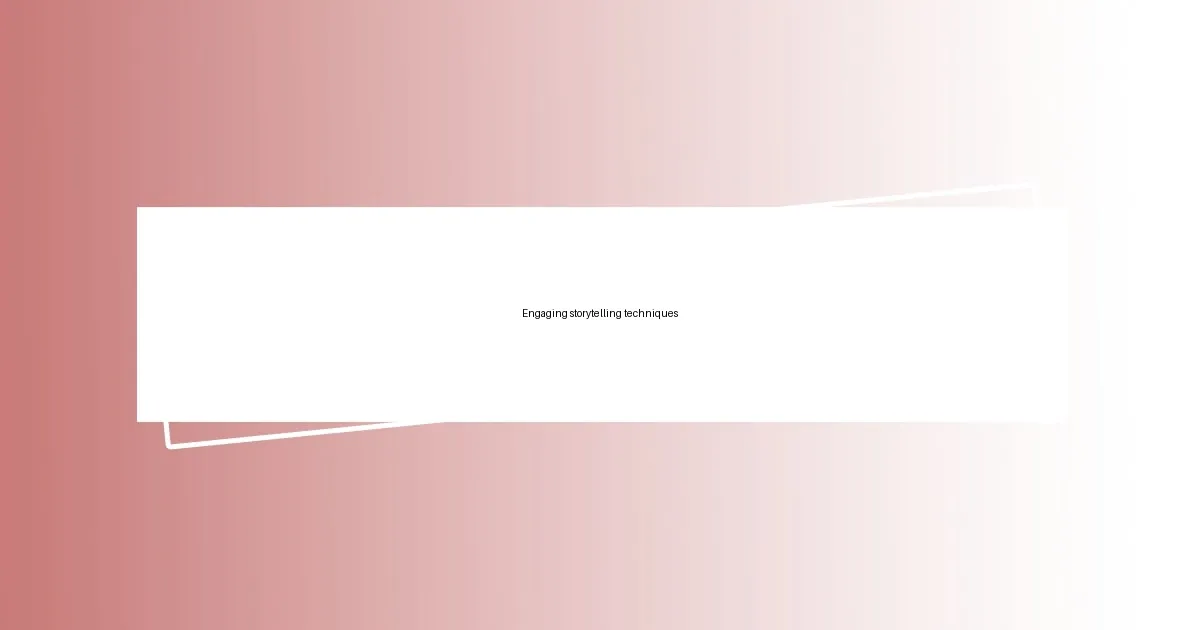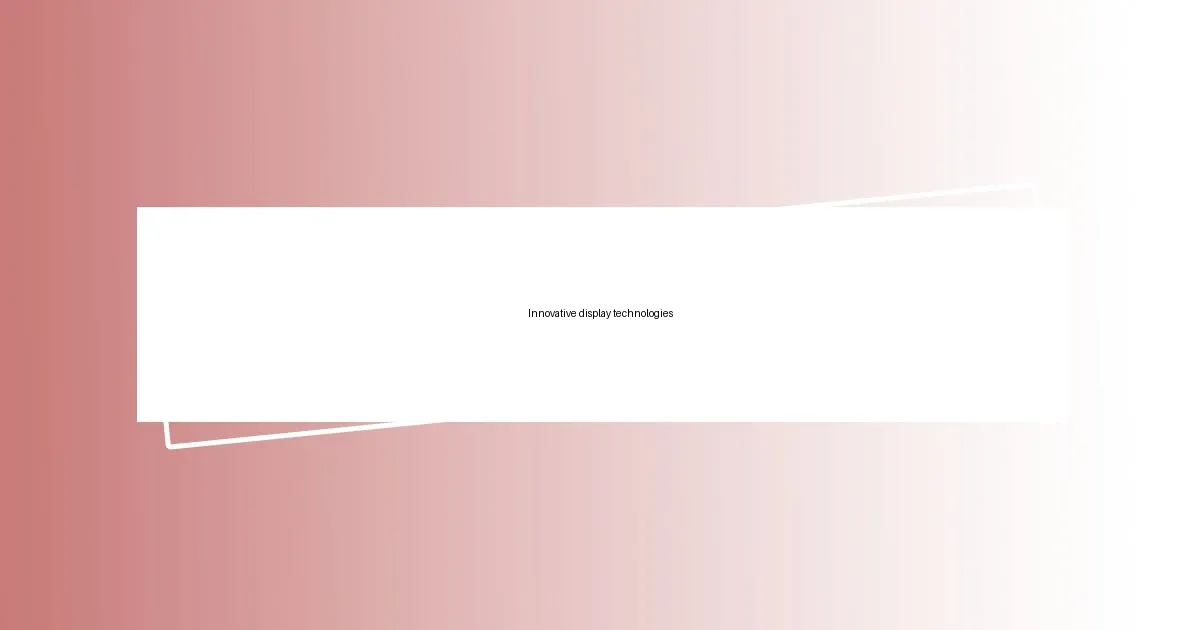Key takeaways:
- Exhibition design focuses on creating immersive experiences through narrative flow, simplicity, and effective use of space.
- Engaging storytelling, including character-driven narratives and visual elements, enhances visitor connections and retention of information.
- Innovative display technologies, like augmented reality and projection mapping, transform exhibitions into interactive and relatable experiences.
- Collaboration with vendors and measuring success through visitor engagement, foot traffic analysis, and social media reach are crucial for effective exhibition design.

Understanding exhibition design principles
Exhibition design is more than just arranging objects in a space; it’s about creating an experience that resonates with visitors. I remember my first time walking through a well-designed exhibition and feeling genuinely immersed in the story being told. It made me realize how important it is to think about the narrative flow—how each piece connects to the next, guiding visitors through an emotional journey.
One crucial principle to keep in mind is simplicity. I once attended a show where the clutter was overwhelming, and instead of enjoying the exhibits, I felt stressed and distracted. Striking a balance between engaging visuals and clear communication makes all the difference. Have you ever wondered why some exhibitions stick with you long after you’ve left? It often comes down to how effectively they convey their message without overwhelming the senses.
Lighting also plays a key role in how we perceive exhibits. I’ve seen how the right lighting can transform an ordinary display into something magical. Whether it’s highlighting a particular artifact or creating an ambient atmosphere, lighting can evoke emotions and enhance the overall experience. To me, this attention to detail is what separates a good exhibition from a great one.

Importance of visitor experience
Creating a memorable visitor experience is fundamental in exhibition design. I recall attending an exhibition where every corner encouraged exploration, making me feel like an active participant rather than a passive observer. This sense of engagement can make or break a visitor’s impression, and I firmly believe that guiding people emotionally can lead to lasting memories.
Moreover, the way an exhibition is structured can drastically influence visitor interaction. I once wandered through a space that expertly used storytelling techniques to weave exhibits together, making me feel connected to the theme. It’s fascinating how a well-thought-out flow can turn a standard show into a cohesive journey that captivates and informs. Have you noticed how some spaces invite you to linger, while others rush you along? That’s the power of thoughtful design at work.
Finally, understanding visitor experience means considering accessibility. I once experienced a barrier that made it difficult for some individuals to appreciate an exhibition fully. Ensuring that each visitor, regardless of ability, can engage with the displays is not just essential—it’s a form of respect. This approach not only broadens the audience but also enriches the experience for everyone who walks through those doors.
| Key Aspects | Examples from Experience |
|---|---|
| Engagement | Exhibition encouraged exploration and active participation. |
| Storytelling | Structural flow that connected exhibits, creating a cohesive journey. |
| Accessibility | Addressing barriers to ensure everyone can enjoy the experience. |

Effective use of space
Effective use of space is essential in creating an inviting atmosphere within an exhibition. I remember visiting a gallery where each area felt distinct yet seamlessly connected. The designer effectively used open areas to allow visitors to pause, reflect, and absorb the content or artwork displayed. It’s remarkable how a well-placed bench or a spacious corner can invite contemplation.
Here are key considerations for leveraging space effectively:
- Flow: Design pathways that guide visitors naturally through the exhibition.
- Zoning: Create defined areas for different types of exhibits or activities, allowing for diverse experiences within the same space.
- Breathing Room: Maintain open spaces to avoid crowding, encouraging visitors to take their time.
- Interaction Zones: Designate spaces for hands-on engagement, where people feel welcome to touch and explore.
- Visual Sightlines: Arrange displays to ensure visibility from multiple vantage points, inviting curiosity from visitors.
I believe that using space effectively isn’t just about practicality; it’s about crafting an emotional landscape. I once attended an art exhibit where each piece was set against vast, stark walls, which amplified their impact. The contrast drew me in, making me feel small in the presence of such creativity, truly enhancing my appreciation for the art. It taught me that spatial dynamics are as much about emotional engagement as they are about physical arrangement.

Engaging storytelling techniques
Incorporating storytelling techniques into exhibition design can turn an ordinary visit into an unforgettable experience. I once encountered an exhibition that began with a narrative hook, drawing me in with an engaging video that set the tone and context. It made me wonder—how often do we see exhibitions that capture our attention right from the start? This strategic approach to storytelling ensured that I was emotionally invested before I even stepped into the main space.
I’ve also seen the power of character-driven stories in exhibitions. At a historical display, each section featured personal accounts and interactive elements, allowing visitors to step into the shoes of real people from the past. This technique not only made historical facts memorable, but it also sparked a sense of empathy in me. When stories resonate on a personal level, don’t you find that they stick with you longer? I’ve carried those narratives with me, deepened my understanding of the topic, and enhanced my overall appreciation for the exhibition.
Visual storytelling plays a crucial role as well. I remember walking through a design exhibit where each wall was adorned with vibrant infographics and illustrations that narrated the evolution of design over decades. It wasn’t just information on a board; it was like being part of a compelling saga that unfolded as I moved through space. This approach left me pondering how visual elements can shape our understanding. When designers harness the magic of visuals in storytelling, it transforms an exhibition into a rich tapestry of ideas and emotions, making it a journey worth taking.

Innovative display technologies

Innovative display technologies
Innovative display technologies have the power to elevate an exhibition from a simple showcase to an immersive experience. I recall visiting a technology fair where interactive screens brought products to life, allowing visitors to engage hands-on. Isn’t it fascinating how a simple touch can convey so much information? It made me feel like a participant rather than just an observer, deepening my connection with the exhibits.
Another standout moment for me was when I encountered augmented reality (AR) in a science exhibit. By simply aiming my smartphone at certain displays, I could see animations and additional content that elucidated complex concepts. This blend of the real and the digital left me amazed and wanting to learn more. Can you remember a time when technology reshaped your understanding? Those layers of information transformed my learning, making abstract ideas tangible and relatable.
The integration of projection mapping stands out as a transformative technique I’ve seen used creatively in recent exhibitions. I once stood in awe as a static backdrop morphed into a vivid storytelling canvas through projected images. Each scene seamlessly flowed, capturing the audience’s imagination. This experience made me ponder—how much more engaging can exhibitions become with such dynamic visuals? It’s a testament to how innovative technologies can not only enhance aesthetics but also deliver narratives in ways we never thought possible.

Tips for collaboration with vendors
When working with vendors, clear communication is essential. I remember a project where misalignment on design specifications led to costly delays. By establishing open lines of dialogue from the start, we could share ideas and expectations freely. Can you imagine the frustration of sitting in a meeting without clarity? I’ve learned that proactive conversations can save time and energy down the line.
Building relationships with vendors isn’t just about the business aspect; it’s about finding common ground. I’ve had experiences where a little personal touch, like sharing a coffee or discussing design inspirations, made a world of difference. These moments not only foster trust but allow them to understand my vision better. How often do we overlook the human element in professional settings? Creating rapport can lead to more inventive solutions that align with your goals.
Lastly, I strongly believe in involving vendors in the creative process. I’ve seen how collaborative brainstorming can spark ideas that I hadn’t initially considered. One time, a vendor suggested a unique material that perfectly complemented our theme. That input transformed the exhibit into something truly special. Have you seen the magic happen when ideas collide? Engaging them in discussions can lead to innovative outcomes that elevate the entire exhibition.

Measuring success in exhibition design
When I think about measuring success in exhibition design, I often reflect on visitor engagement. For instance, during an art exhibition I helped design, we used surveys to capture attendee feedback. The responses were an eye-opener; many visitors shared how certain installations resonated with them personally. Isn’t it fascinating how emotional connections can be quantified through simple feedback?
Another vital metric I consider is foot traffic analysis. I once collaborated on a major trade show where we strategically positioned key displays to draw visitors in. After reviewing the data, we learned that a specific layout drew in significantly more attendees than anticipated. It amazed me how something as seemingly mundane as foot traffic could tell a story about our design’s effectiveness. Have you ever experienced a moment where data revealed the impact of your design choices?
Lastly, I believe in the power of social media reach as a success indicator. I remember launching an exhibition that inspired visitors to share their experiences online; the hashtag we created quickly gained traction. It’s astonishing how digital engagement can reflect the real-world impact of an exhibition. This made me ponder—what if we could harness that online energy to shape future designs? Social media isn’t just a marketing tool; it’s a dynamic avenue for understanding audience perceptions and shaping our creative endeavors.














